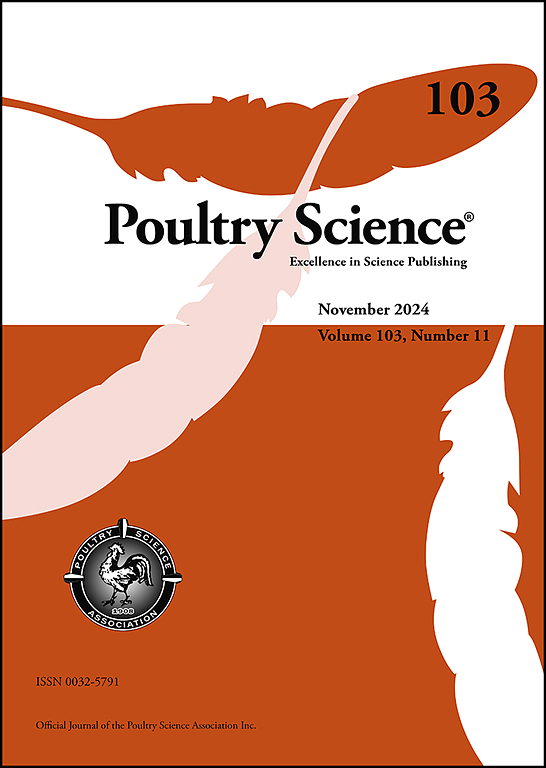全双列杂交对4个鸡品种产蛋性状的遗传分析
IF 4.2
1区 农林科学
Q1 AGRICULTURE, DAIRY & ANIMAL SCIENCE
引用次数: 0
摘要
本研究采用4 × 4全双列杂交,评价了杂交对产蛋率性状的影响。4个鸡品种:改良Horro (H)、Sasso (S)、Potchefstroom Koekoek (K)和Dz-white feathered (D)。试验选用800只鸡,采用完全随机设计。在40周(WK)内收集产蛋性状数据。基因型表现出显著差异(P <;0.0001)与初蛋龄(AFE)、性成熟体重(BWSM)、初蛋重(EWAFE)、蛋数(EN)、母鸡舍产蛋量(HHEP)、母鸡日产蛋量(HDEP)和产蛋量(EM)之间的关系。杂种优势效应(He)差异很大,在大多数杂交中,BWSM和EM的He均为正,而AFE的He均为负。除H × S和H × d外,正交对EWAFE的He均呈阳性,正交对HHEP(26.85%)、HDEP(29.44%)、EM(40.88%)和EN(28.27%)的He均为阴性。杂交D × H对HHEP(25.16%)和EN(24.60%)也表现出较强的He, K × S对HDEP(22.60%)和EM(33.89%)表现出较强的He。除AFE外,BWSM、EWAFE、HHEP、HDEP、EM和EN的正交He均呈阳性。一般配合力(GCA)和特定配合力(SCA)效应极显著(P <;0.0001)。互惠效应(RE)和母性效应(Me)也影响性状的表达。GCA/SCA比值表明,非加性效应影响AFE,而加性效应影响EWAFE。HHEP, HDEP, EM和EN的适度比例表明可加性和非可加性效应之间的平衡。为提高产蛋率,建议优化杂交策略,配合品种综合发展,选用K系配H、S系,D系配H系。本文章由计算机程序翻译,如有差异,请以英文原文为准。
Genetic analysis of egg production traits in four chicken breeds using a full diallel cross
In the present study, effects of crossbreeding on egg production traits were evaluated using a 4 × 4 full diallel cross involving four chicken breeds: Improved Horro (H), Sasso (S), Potchefstroom Koekoek (K), and Dz-white feathered (D). The experiment included 800 chickens in a completely randomized design. Data on egg production traits were collected over 40 weeks (WK). Genotypes exhibited significant variations (P < 0.0001) in age at first egg (AFE), body weight at sexual maturity (BWSM), egg weight at first egg (EWAFE), egg number (EN), hen-housed egg production (HHEP), hen-day egg production (HDEP), and egg mass (EM). Heterosis effects (He) varied widely, with positive He for BWSM and EM in most crosses, while AFE consistently showed negative He. All reciprocal crosses showed positive He for EWAFE, while direct crosses had negative values except H × S and H × D. The K × H cross showed the highest He for HHEP (26.85 %), HDEP (29.44 %), EM (40.88 %), and EN (28.27 %). The cross D × H also exhibited strong He for HHEP (25.16 %) and EN (24.60 %), while K × S ranked second for HDEP (22.60 %) and EM (33.89 %). Reciprocal crosses showed positive He for BWSM, EWAFE, HHEP, HDEP, EM, and EN, except AFE. General combining ability (GCA) and specific combining ability (SCA) effects were highly significant (P < 0.0001) for all traits. Reciprocal effects (RE) and maternal effects (Me) also influenced trait expression. GCA/SCA ratios indicated that non-additive effects influenced AFE, while additive effects influenced EWAFE. Moderate ratios for HHEP, HDEP, EM, and EN suggested a balance between additive and non-additive effects. Optimizing crossbreeding strategies, aligning with synthetic breed development, using a K sire with H and S dams, and a D sire with H dam, is recommended to improve egg production.
求助全文
通过发布文献求助,成功后即可免费获取论文全文。
去求助
来源期刊

Poultry Science
农林科学-奶制品与动物科学
CiteScore
7.60
自引率
15.90%
发文量
0
审稿时长
94 days
期刊介绍:
First self-published in 1921, Poultry Science is an internationally renowned monthly journal, known as the authoritative source for a broad range of poultry information and high-caliber research. The journal plays a pivotal role in the dissemination of preeminent poultry-related knowledge across all disciplines. As of January 2020, Poultry Science will become an Open Access journal with no subscription charges, meaning authors who publish here can make their research immediately, permanently, and freely accessible worldwide while retaining copyright to their work. Papers submitted for publication after October 1, 2019 will be published as Open Access papers.
An international journal, Poultry Science publishes original papers, research notes, symposium papers, and reviews of basic science as applied to poultry. This authoritative source of poultry information is consistently ranked by ISI Impact Factor as one of the top 10 agriculture, dairy and animal science journals to deliver high-caliber research. Currently it is the highest-ranked (by Impact Factor and Eigenfactor) journal dedicated to publishing poultry research. Subject areas include breeding, genetics, education, production, management, environment, health, behavior, welfare, immunology, molecular biology, metabolism, nutrition, physiology, reproduction, processing, and products.
 求助内容:
求助内容: 应助结果提醒方式:
应助结果提醒方式:


